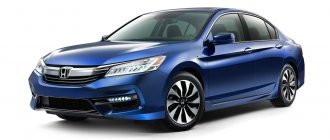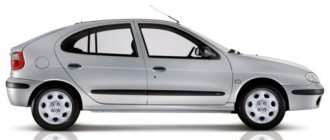Honda CR-V
The Honda CR-V sports SUV quickly burst onto the automobile market back in 1995. The CR-V, which translates to "Comfortable Recreational Vehicle," was indeed just that. First of all, it is worth noting its driving performance, since the all-wheel drive SUV is characterized by high cross-country ability and an excellent level of comfort. The interior of the Honda CR-V is elegant enough for an all-terrain vehicle, comfortable and spacious enough to get out of town. Its trunk is very roomy, and the internal transformation is very useful on long journeys. Although it is quite large inside, the developers were able to make it compact in appearance and one of the most maneuverable cars in the SUV class.
The Honda SRV engine does not cause any trouble to its owners and has an enviable service life. Experts advise using oil with a specification not lower than SJ into the Honda CR-V engine; it is better not to use mineral oil. The new Honda CRV comes with a five-speed manual or four-speed automatic transmission equipped with Grade Logic. The automatic transmission gear shift lever is located next to the steering wheel on the dashboard in close proximity to the driver of the Honda CR-V.
Story
In Europe, sales of this model began in 1997, and the new product quickly gained popularity due to its pleasant appearance, comfortable interior, excellent driving characteristics and a level of quality that fully justifies the status of Honda products.
The start of production of the European version of the model occurred in 2000 in England. And at the end of next year, the second generation of this model rolled off the assembly line, incorporating the best features of its predecessor. At the same time, all-wheel drive options appeared, which only emphasized the off-road qualities of the Honda CR-V. Innovations allowed the second generation of this model to become more economical with increased productivity. This was facilitated by a new two-liter engine and a special body design, which made it possible to increase the interior space of the car, making the interior more spacious and comfortable.
The third generation of the model appeared in 2007. A special feature of this version is the vertical opening of the rear door, which was made possible by removing the spare wheel from it. The third generation CR-V can offer the driver significantly improved handling dynamics. Compared to its predecessors, the car has become wider, shorter and lower.
The fourth generation of the model has become even more practical and sophisticated, combining these qualities with improved technical characteristics. Honda CR-V received appropriate improvements that allowed it to become closer to the European consumer. According to Ryuji Nakagawa, chief project manager for the development of the CR-V, if in 1995 Honda set itself the goal of creating a car that combined the features of an SUV and a passenger car, then the fourth generation of the model has an ideal balance between the safety of an SUV and the functionality of a passenger car. The latest generation CR-V is a versatile car with excellent technical characteristics.
Interior and exterior
The exterior of the car perfectly combines the characteristics of a passenger car and an SUV with a slight touch of “sportiness”. Thanks to the width of the car at 1780 mm, proper stability is felt when driving, while the increased size of the body has a positive effect on the density of the frame, which is provided by two types of rear pillars.
The interior is designed in a classic style and is standard for most passenger cars. For example, the parking brake levers located next to the driver’s seat look very ordinary. At the same time, some car enthusiasts may find the interior of the CR-V simple, for a car of this class. But here we should understand the manufacturer’s focus on creating a car that fully incorporates the features of both an SUV and a passenger car. In terms of functionality, the Honda model has an excellent interior with a large number of control buttons located on the steering wheel and dashboard, which is quite convenient. In the new versions, the interior is two-tone: beige on the bottom gives way to a stylish gray on top. This brings freshness and style to the interior.
In the latest generations of the model, there are trends towards increasing car comfort. For example, the length of the cabin has increased by 65 mm, and accordingly, the size of the seats has also increased. The rear seat received a sliding mechanism, and the luggage compartment floor was lowered by 120 mm.
Externally, the car is a typical representative of its class. It has a swift and bright appearance, which at the same time has all the features of an SUV. Although the car is visually large, it does not take up much space in the parking lot. Unlike large SUVs, you don’t feel any discomfort behind the wheel of this car when driving in urban conditions, since the model is very compact. The sporty body and powerful engine allow you to feel great both in city traffic and on country roads.
Technical features
The main feature of Honda is its proprietary all-wheel drive system, called Real Time 4WD. It is implemented as follows: when driving in normal mode, torque is transmitted to the front axle of the car. However, in the event of slipping, the rear-wheel drive immediately engages. This approach allows you to significantly save fuel, because in this case the rear-wheel drive is disabled most of the time.
Compared to the first two generations, subsequent versions received significantly improved drives. If previously the rear axle was put into operation thanks to a multi-plate clutch controlled by hydraulic pumps, then it took several seconds to activate this system. And in emergency situations it was extremely inconvenient. Starting from the third generation, Honda installs a freewheel on the CR-V, which instantly comes into operation, eliminating slipping of the front wheels. Thus, the rear-wheel drive starts almost without delay.
Honda SRV also has modern safety systems. In particular, this is automatic brake control, which initially warns the driver of a high likelihood of a collision, but if there is no response, it begins to control the brake system independently.
The car also has a TSA stabilization system, which will greatly facilitate driving with a trailer. When a trailer gets into a skid, this system begins to slow down the wheels of the car to prevent it from going into a ditch. The system creates an antiphase to vibrations by acting on the wheels diagonally, for example, on the right rear and left front. In addition, the electronics are also capable of reducing the amount of fuel supplied to the cylinders, which allows the car to slow down.
Engine and transmission
The most popular engine in the CR-V is the two-liter i-VTEC. Its power in the latest generation has increased from 150 to 155 horsepower. Some car enthusiasts believe that such an engine is somewhat insufficient for such a car. However, it is the two-liter engine that allows this model to combine good driving performance with high efficiency.
If we talk about the transmission, the consumer can choose from a 5-speed automatic or 6-speed manual. According to the technical data sheet, the acceleration of a car with a manual transmission is 2 seconds higher than the same model with an automatic transmission installed. However, you can feel the increase in dynamics only if you reach a speed of 6000, which is not recommended in urban conditions.
It should be noted that there is no manual mode in the automatic transmission, but instead there is a fundamentally new Grade Logic system implemented here. Its essence is to analyze driving behavior by measuring speed, acceleration and braking. After this, based on the data received, the computer independently selects the optimal gear shift mode that best suits the driving style of the car owner.
Comparison with competitors
Honda SRV is a real long-liver among cars in its class. Among the main competitors of this model are the following cars: Toyota RAV4, Ford Kuga, Skoda Yeti and Volkswagen Tiguan. In comparison, the Honda CR-V stands out for its reliability, handling and spaciousness. The disadvantage of this car is that the basic version does not have the best sound insulation.
One of the main advantages of the third generation CR-V is its high ergonomics. The interior has a large number of different boxes, shelves and drawers. In addition, the car interior itself has ample opportunities for transformation. For example, the rear seats, which have a 60:40 proportional ratio, can slide forward by 15 cm.
It should also be noted that there are a large number of options for installing child car seats, because the model has 5 Isofix anchorages. So that parents can watch their children while driving, there is a special panoramic mirror in the cabin.
One of the main advantages in Honda ergonomics has always been its spacious trunk. In the third generation, its volume decreased slightly compared to the second, but in the fourth update, the manufacturers rehabilitated themselves by providing the car with a truly spacious trunk. Using a rigid horizontal shelf, you can divide the trunk into two parts if necessary. This is very convenient when transporting different types of cargo at the same time.
Interesting features
According to research by the American company TrueCar, it became known that more than half of Honda CR-V owners in the United States are women. According to data for 2010, almost 52% of women drove this crossover.
The CR-V III is the model that has undergone major upgrades more often than others, which also speaks to the level of support from the manufacturer. For example, in 2011, a series of these cars were recalled to reconfigure the airbags to achieve maximum protection when deployed.
Honda CR-V first generation (description and characteristics)
Similar articles
- Honda Fit (Honda Jazz) first generation (description and characteristics)
- Honda regulations
- Honda models
The history of the Honda CR-V (Honda SRV, or CRV) is a story about the birth of a new standard of cars, which occurred thanks to the design experiments of Honda.
In the mid-90s of the twentieth century, a new project was being prepared in the bowels of the Honda Research Institute - a compact car with the ability to travel over rough terrain, and a high level of equipment for its class, both from a technical point of view and in terms of comfort. The result of serious developments was the first generation Honda CR-V.
Appearing on the Japanese market at the end of 1995, this car once and for all changed the attitude towards the SUV segment. Starting with the Honda CR-V, the history of cars with the practicality of a station wagon and improved cross-country ability begins. The abbreviation CR-V itself means “Comfortable Recreational Vehicle” - “Car for a comfortable holiday”, its concept is already reflected in the name. What made the CR-V successful? Many companies have already tried to create something similar, but only Honda managed to create a truly masterpiece.
Firstly, the great new B20B engine. Being a “relative” of the legendary B16A (B16B), this wonderful, balanced two-shaft engine never received VTEC, but even without it it produced 130 hp sufficient for this car, especially since a small restyling carried out in 1998 added more to it 20 hp
Secondly, this is the transmission. Initially, Honda offered only one option - a classic automatic transmission. Just a year later, a manual version appeared.
Thirdly, all-wheel drive. Initially, only an all-wheel drive version was produced, powered by the DPS system. Later, front-wheel drive versions appeared, but the bulk were produced with all-wheel drive.
Fourthly, the suspension design. Initially, there were concerns that the heavier body, based on the Honda Civic EG, would lead to rapid wear of the suspension. But all the spiteful critics missed the mark. It’s hard to come up with a more reliable suspension model than a multi-link scheme at the rear and two levers at the front, but in Honda’s version this scheme turned out to be almost perfect. The design of the suspension was so successful that often no additional maintenance was required during the entire warranty period (100,000 km). Many nodes were nursed for two times!
Fifthly, the salon. The interior comfort of the CR-V in the first body is still considered a model for its class.
Sixthly, controllability and cross-country ability. The Honda CR-V had excellent cross-country ability for its class. Of course, it makes no sense to compare it with real SUVs, but this is not required - this car was required to be able to get to a picnic site away from the road. Sedans, hatchbacks, standard station wagons, which usually got stuck on the road or “collected” all the bumps on the bottom, could not compete with the new Honda model with its 200 mm ground clearance! At the same time, on the highway the CR-V handled like a regular front-wheel drive station wagon.
Based on the sum of all the advantages, the Honda CR-V was in the lead by a huge margin over its competitors. The whole world became the sales markets for the new model - Japan, the USA, even conservative Europe could not resist this masterpiece from Honda. By the way, the configurations of cars in different markets were almost identical.
The model was produced for six years, until 2001, without undergoing any major changes.
Years of production – 1995-2001
Length – 4470
Width – 1750
Height – 1705
Ground clearance – 205
Engine -
Until 1998 - B20B - power 130/5500 hp/rpm, torque - 192/4200 Nm/rpm
After 1998 - B20B - power 150/6300 hp/rpm, torque - 188/4500 Nm/rpm
Anterior, transverse location.
Suspension: two wishbones at the front, multi-link system at the rear.
The drive is all-wheel drive, thanks to the DPS system (RD2 – front-wheel drive).
Transmission – automatic transmission (classic type), manual transmission.
Scheduled maintenance intervals
Read the article about first generation Honda CR-V engines:
Honda motors. B series engines (B16, B18, B20)
If you find an error, please select a piece of text and press Ctrl+Enter.
More interesting articles











